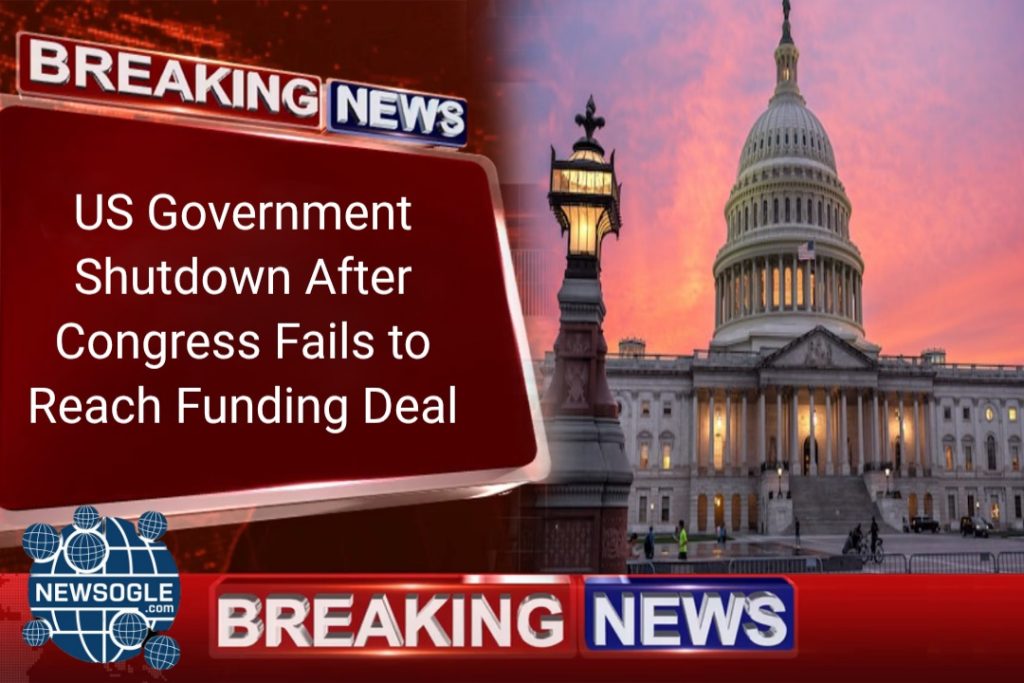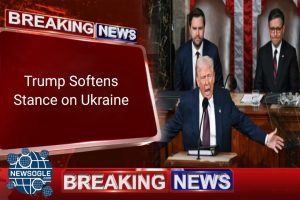
By Our Washington Bureau
October 1, 2025
For the second time in a decade, and in a jarring testament to the enduring volatility of partisan politics in Washington, the United States federal government has officially shut down. At the stroke of midnight on October 1st, the deadline for Congress to pass legislation funding government operations, the necessary appropriations bills expired. The closure was triggered after the Democratic-controlled Senate decisively rejected a last-ditch Republican funding plan put forth by the House, which was laden with controversial spending cuts and divisive policy riders deemed “poison pills” by the opposing party.
The failure to pass a Continuing Resolution (CR) plunges hundreds of thousands of federal employees into furlough, effectively halting non-essential government functions and raising immediate concerns about the economy, public safety, and critical national services. This shutdown, unfolding against a backdrop of razor-thin congressional majorities and simmering ideological warfare, promises to be one of the most fraught budget impasses in recent memory, with no clear path to resolution in sight.
Immediate Impact: A Nation on Hold
The effects of a federal government shutdown are swift, comprehensive, and widely felt, extending far beyond the marble halls of the Capitol. As of this morning, approximately 800,000 federal employees are designated as “non-essential” and have been instructed to stay home without pay. Crucially, even “essential” employees—such as Transportation Security Administration (TSA) agents, border patrol, military personnel, and air traffic controllers—must report to work without guarantee of timely compensation, creating significant morale and financial hardship for the nation’s workforce.
National Parks and Museums: Across the country, the gates of beloved National Parks are locked, campgrounds are closed, and visitor centers are dark, representing an immediate loss for the tourism sector and the travelling public. Similarly, the world-renowned museums and galleries of the Smithsonian Institution in Washington, D.C., and beyond, have ceased operations.
Economic and Administrative Disruptions: Critical administrative functions are immediately affected. The Internal Revenue Service (IRS) drastically scales back operations, delaying the issuance of tax refunds, hindering audit activity, and crippling preparation for the upcoming tax season. Small business owners relying on loans from the Small Business Administration (SBA) face processing delays, effectively putting investment and hiring plans on hold. Furthermore, many scientific research projects funded by agencies like the National Institutes of Health (NIH) and the Centers for Disease Control and Prevention (CDC) are suspended, potentially losing valuable data and momentum on life-saving work.
Safety and Security: While core security operations continue, the strain is visible. TSA checkpoints will remain open, but staffing shortages—often worsened by essential workers calling out due to lack of pay—could lead to extended wait times at major airports. Border security personnel remain on duty, but key support and administrative staff are furloughed, complicating operational effectiveness. The essential services of the U.S. Military are maintained, but civilian support staff for bases and maintenance are sidelined, creating a growing backlog of tasks. The Veterans Health Administration (VA) will continue to provide healthcare services, but functions like benefits processing and claims review are expected to slow down considerably.
This widespread operational halt amounts to an immediate, self-inflicted wound on national governance, costing the U.S. economy billions of dollars for every week the closure persists.
The Political Crucible: A Battle of Ideologies
The crisis emerged from an intractable dispute over government funding for the next fiscal year. The Republican majority in the House, facing intense pressure from its most conservative flank, insisted on a funding bill that went far beyond a simple extension of current spending. Their bill, which was rejected by Senate Democrats, contained several deep spending cuts and hardline policy riders.
The Republican Stance: Deficit Reduction and Policy Demands
House Republicans framed their failed proposal as a necessary step to address the nation’s ballooning deficit and restore fiscal sanity. The plan demanded immediate, non-negotiable cuts to several discretionary spending accounts, targeting environmental protection, social services, and education programs.
But the true flashpoint was the inclusion of controversial, non-fiscal measures—the aforementioned “poison pills.” These included stringent new measures on border security and specific language banning certain public health policies that are widely supported by the Democratic base.
House Speaker Marcus Thorne, speaking shortly after the Senate vote, cast the blame squarely on the opposition. “We offered a responsible plan that cuts waste and secures our borders,” Thorne declared. “The Democrats’ refusal to negotiate, their insistence on a ‘clean’ bill that ignores the public’s demands for fiscal discipline and border control, is what has led us to this painful, unnecessary shutdown. They prefer political theater to governing.” Thorne and his allies argue that they are simply standing up for the core principles they were elected on, refusing to pass a “blank check” to the administration.
The Democratic Refusal: Rejection of Policy Riders
Senate Majority Leader Eleanor Vance and her Democratic caucus were unanimous in their rejection of the House bill. Democrats argued that the inclusion of major, highly contentious policy changes in a must-pass funding bill was an abuse of the legislative process and a cynical attempt to achieve extreme goals through fiscal coercion.
“We will not negotiate with hostage-takers,” Vance stated emphatically during a floor speech. “A funding bill is meant to keep the lights on, not to rewrite bedrock environmental laws or strip healthcare access from vulnerable Americans. We are ready to pass a clean, short-term Continuing Resolution right now, which would provide the breathing room necessary for rational, good-faith negotiation on the full-year budget. The Republican House leadership chose chaos over compromise.”
Democrats view the proposed spending cuts as catastrophic to working families and essential government services, and they contend that attaching unrelated, highly ideological policy riders violates the spirit of bipartisan governance required to pass appropriations. Their strategy is to hold firm on the demand for a clean CR, banking on rising public anger over the shutdown to eventually force House Republicans to back down and compromise.
Historical Echoes and Current Dynamics
This 2025 shutdown is not an isolated event but a continuation of a volatile trend in modern American governance. The U.S. has seen several significant closures in the past three decades, notably the mid-1990s battles between President Clinton and Speaker Gingrich, the 2013 closure during the Obama administration over the Affordable Care Act, and the record-setting 35-day shutdown of 2018-2019 under President Trump over border wall funding.
However, the current dynamic carries unique characteristics that make a quick resolution highly improbable.
The House’s Fragility: Speaker Thorne leads a House majority so thin that a handful of hardline conservatives can effectively veto any spending package that is not to their liking. This small, powerful bloc demands ideological purity and has demonstrated a willingness to tolerate a shutdown—or even use it as leverage—to achieve their policy goals. This internal Republican division is arguably a greater obstacle than the partisan divide with the Democrats.
Senate Unity: Conversely, the Senate Democratic caucus, supported by moderate Republicans, appears remarkably unified in its opposition to the House’s policy riders. This unity prevents any attempt by the House to peel off moderate votes for its current proposal.
Post-Election Positioning: This shutdown occurs less than a year after a pivotal general election. Both parties are acutely aware that their current actions will form the basis of their messaging in the next cycle. Republicans are seeking to prove their fiscal bona fides, while Democrats are eager to paint the GOP as the party of legislative obstruction and government dysfunction. The political stakes are therefore enormous, further cementing both sides into their current positions.
The Economic Shudder: Markets React to Instability
The immediate economic reaction to the closure has been one of anxiety and instability. Asian markets opened lower, and futures for U.S. equities signaled a choppy opening as investors digested the news of political dysfunction.
Credit Rating Concerns: Perhaps the most significant worry among economists is the potential impact on the nation’s sovereign credit rating. Just over a year ago, the U.S. credit rating was downgraded following another bout of political brinkmanship over the debt ceiling. Analysts fear that a protracted government shutdown, demonstrating an inability to execute basic financial governance, could trigger further downgrades, which would increase the cost of borrowing for the federal government and, consequently, for everyday consumers.
Dr. Clara Denton, Chief Economist at the Peterson Institute for International Economics, warned of the wider consequences. “This isn’t just about federal paychecks; it’s about economic uncertainty,” Dr. Denton noted. “Every week the government is closed, we see a subtraction of roughly 0.1 to 0.2 percentage points from quarterly GDP growth. Businesses halt investment, consumer confidence dips, and the rest of the world sees a highly unstable partner. The long-term damage to the U.S. reputation as a predictable economic force is arguably greater than the immediate fiscal cost.”
Ripple Effects on Commerce: The closure of the Securities and Exchange Commission (SEC) means that new Initial Public Offerings (IPOs) are effectively halted, freezing capital market activity. Furthermore, delays in federal contracting and permitting processes impact major infrastructure and defense projects, disrupting the supply chains of thousands of private sector contractors.
Agency-by-Agency Impact: Where the Rubber Stops Hitting the Road
The shutdown’s severity is best understood through the granular impact on specific federal agencies and the citizens they serve:
Public Health and Research (NIH/CDC): Key clinical trials at the National Institutes of Health (NIH) are being suspended, potentially jeopardizing treatment for patients relying on experimental therapies. The Centers for Disease Control and Prevention (CDC) is forced to reduce essential disease surveillance and outbreak response activities, raising concerns about the nation’s ability to track and contain emerging public health threats, especially as the flu season approaches.
Veterans Affairs (VA): While core medical services continue, the VA’s administrative functions—processing disability claims, educational benefits, and housing assistance—grind to a near halt. This creates immense financial strain on veterans and their families who rely on timely disbursements. Veterans’ advocates have been vocal, calling the shutdown “a betrayal of those who served.”
Small Business and Housing: The Department of Housing and Urban Development (HUD) ceases inspections, which impacts tenants in federal housing projects. Likewise, the halting of loan processing by the Small Business Administration (SBA) starves thousands of small businesses of essential capital needed for growth and payroll.
Environmental Protection: The Environmental Protection Agency (EPA) suspends site inspections and enforcement activities, leaving environmental protection efforts largely unmonitored. This raises immediate fears among environmental groups about corporate non-compliance during the period of lapsed oversight.
Financial Regulation: Key functions of the Commodity Futures Trading Commission (CFTC) and the Federal Communications Commission (FCC) are paused, complicating regulatory oversight of the financial and communications sectors at a time of increasing global instability.
Public Frustration and the Blame Game
Polling conducted in the final hours leading up to the shutdown indicated widespread public disapproval, with a significant majority of Americans expressing frustration with Congress’s inability to perform its fundamental duty. Early indications suggest the Republican Party is likely to bear the brunt of public blame, primarily because they control the House and initiated the demand for policy riders that led to the impasse.
However, the Democratic Party is not immune to criticism. Some centrist voices argue that refusing to negotiate on even a temporary measure, while adhering strictly to a “clean CR” demand, amounts to an equal display of legislative rigidity.
Labor unions, representing hundreds of thousands of furloughed workers, have organized immediate protests near the Capitol, demanding that Congress pass a bill that includes retroactive pay for all federal employees and a permanent guarantee that essential workers will not be forced to work without pay in future disputes. Business leaders from the U.S. Chamber of Commerce have also weighed in, urging an immediate bipartisan solution to restore market stability and ensure the continuous flow of commerce.
The Path Forward: Senate Pressure and the Search for an Off-Ramp
With the government officially closed, the pressure for a resolution shifts immediately to House Speaker Thorne. Historically, the party perceived as initiating the shutdown eventually yields under the weight of negative public opinion and economic harm.
The immediate action lies with the Senate. Majority Leader Vance is expected to hold symbolic votes on a clean, short-term Continuing Resolution—a measure that would fund the government for 30 to 45 days without policy riders—to demonstrate the Senate’s readiness to open the government immediately. The political calculus is that if the House were to reject this clean bill multiple times, the pressure on moderate House Republicans to side with Democrats and force a vote to reopen the government would become overwhelming.
Negotiations are expected to be conducted behind closed doors over the coming days, involving top congressional leaders and key White House officials. The most likely scenario remains a short-term CR that is either mostly clean or contains minimal, broadly palatable spending cuts, pushed through by a coalition of Democrats and moderate Republicans in the House, effectively bypassing the hardline conservative faction.
The duration of this shutdown is highly uncertain. If a deal is not reached within a week, the financial pain inflicted on federal workers and the American public will begin to escalate sharply, forcing Congress to choose between political posturing and the practical necessities of governance.
Conclusion: The Cost of Legislative Paralysis
The 2025 government shutdown serves as a stark reminder of the immense cost of legislative paralysis and extreme partisan gridlock. Beyond the immediate inconvenience of closed parks and museum doors lies a far deeper threat to economic stability and national security. The failure to pass a funding bill is not just a budget dispute; it is a profound breakdown in the basic machinery of American democracy.
Hundreds of thousands of citizens are now being asked to work for a government that cannot pay them, while millions more see vital public services suspended, all because a small ideological bloc in Congress prioritized policy demands over the functional continuity of the nation. As the U.S. enters this period of operational freeze, the pressure mounts on Washington’s leaders to find an off-ramp—and quickly—before a political stalemate transforms into a genuine national crisis. The coming days will test the ability of the House Speaker to manage his deeply divided caucus and the willingness of both parties to place the needs of the country above the demands of their political bases. The cost of inaction is too high for the government, the economy, and the American people.

Saqqaf Yasir is the PhD on International Relations, also serving as professional Advocate since 2009, he keeps the experience of development sector for more than 32 years and has been writing different types of articles in various newspapers since 1992.




